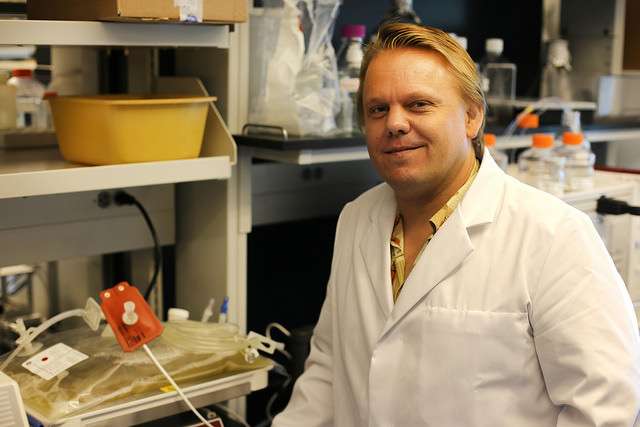Positive preliminary results of a heat stable Ebola vaccine formulation

A biopharmaceutical company collaborating with Hawai'i scientists on an Ebola vaccine announced encouraging news about its vaccine today.
Tests on the vaccine, still in development, have shown it is able to retain its effectiveness without refrigeration. That is a real plus when you are talking about many rural areas in Africa that are most at-risk for another Ebola outbreak.
"What we've just recently shown with the work performed with Soligenix, Inc. at the University of Colorado is that we can dry stabilize the key antigen for the Ebola vaccine so that it basically can be stored at room temperature or elevated temperature—you can almost leave it out in the sun —and it can be stable for up to three months," said Axel Lehrer, PhD, Assistant Professor, Department of Tropical Medicine, Medical Microbiology and Pharmacology at the University of Hawai'i at Mānoa John A. Burns School of Medicine (JABSOM).
The announcement was made by Soligenix, Inc. (OTCQB: SNGX) (Soligenix or the Company), which is a late-stage biopharmaceutical company focused on developing and commercializing products to treat rare diseases where there is an unmet medical need. The company is collaborating with the University of Hawai'i at Mānoa and Hawai'i Biotech, Inc. (HBI) to develop a heat stable subunit Ebola vaccine.
Soligenix said thermostabilization (heat stabilization) formulation studies, conducted with Dr. Theodore Randolph at the University of Colorado, have also shown that the use of thermostable formulations may allow full immunization to potentially be achieved with fewer vaccinations.
"None of the other Ebola vaccines under development have the ability to withstand high temperatures, which is an ongoing concern in areas of the world where Filoviruses are endemic," said Dr. Lehrer. "The ability to stabilize our vaccine candidate to retain immunogenicity may not only have an impact on logistics, but has also the potential to reach more persons at need. A vaccine that needs to be given fewer times increases the likelihood that more people receive sufficient doses of the vaccine to protect them from disease."
"We are very encouraged by these preliminary results and look forward to our continuing collaboration with Soligenix and HBI to further develop our Ebola and multivalent filovirus vaccines," said Dr. Lehrer.
About Ebola
Ebola Virus Disease (EVD) is caused by one of five species of Ebolavirus, four of which cause disease in humans, including its best-known member, Zaire Ebolavirus (Ebola virus). All species of Ebolavirus belong to the Filoviridae family, a family that further contains the equally human pathogenic Marburgvirus. The Ebola virus is believed to be harbored in various animal species in Africa, although the specific reservoir host is still unknown. There have been several known EVD outbreaks in Africa since 1976, with the most recent and largest outbreak starting in 2014 in Western Africa.
Transmission of Ebola requires direct contact of bodily fluids from an infected person or contact with infected animals. The mortality rate from Ebola infection is extremely high, and can sometimes be affected by the quality of supportive care available with a focus on early initiation of treatment. Symptoms of Ebola virus infection include high fever, severe headache, muscle pain, weakness, fatigue, diarrhea, vomiting, abdominal pain and unexplained hemorrhage. Resolution of the disease largely depends on the patient's own immune system. There is no approved treatment and no approved vaccine for Ebola, although research into both has accelerated since the onset of the 2014 outbreak.
The Ebola outbreak of 2014 primarily spanned three West African countries, and involved over 28,000 confirmed/probable/suspected cases with an estimated death toll of more than 11,000 persons according to the Centers for Disease Control and Prevention (CDC), including some cases in Europe and the United States. The widespread nature of the infection and its devastating impact has further illustrated the need to develop an Ebola vaccine to prevent future and possibly more significant outbreaks.
About ThermoVax
ThermoVax® is a technology that is designed to eliminate the standard cold chain production, distribution and storage logistics required for most vaccines. Cold chain requirements add considerable cost to the production and storage of current conventional vaccines. According to the Biopharma Cold Chain Sourcebook of 2010, more than 90% of all vaccines (with a total value of $20.6 billion) require shipment through cold chain. Elimination of the cold chain would also enhance the utility of these vaccines for emerging markets and for other applications requiring but lacking reliable cold chain capabilities. Further, the World Health Organization (WHO) reports that as much as 50% of all global vaccine doses are wasted due, in part, to excursions outside required temperature ranges NIAID has also highlighted the priority of technologies for biodefense vaccines that focus on broad spectrum approaches including vaccine adjuvants and temperature stabilization for long shelf life, rapid onset of immunity, and surge capacity for production. For vaccines that are intended for long-term stockpiling, such as for use in biodefense or in pandemic situations, the utilization of ThermoVax has the potential to facilitate easier storage and distribution of strategic national stockpile vaccines in emergency situations.
The technology utilizes precise lyophilization of protein immunogens with conventional aluminum adjuvants in combination with secondary adjuvants for rapid onset of protective immunity with the fewest number of vaccinations. RiVax is extremely labile in liquid form requiring careful management under refrigerated conditions at 4 degrees Celsius (39 degrees Fahrenheit). By employing ThermoVax during the final formulation, it is possible to produce stable and potent vaccines that are capable of withstanding temperatures at least as high as 40 degrees Celsius (104 degrees Fahrenheit) for up to one year.
The underlying technology has been developed by Drs. John Carpenter and Theodore Randolph at the University of Colorado. The vaccine technology has been developed to date in collaboration with SRI International, the University of Kansas, the Wadsworth Center of the New York State Department of Health, and the Tulane National Primate Research Center under the sponsorship of the cooperative grant from NIAID.
















